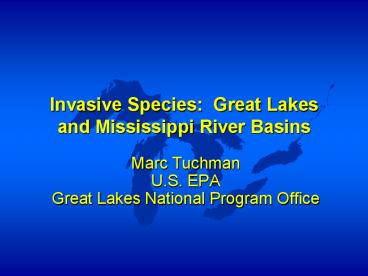Invasive Species: Great Lakes and Mississippi River Basins - PowerPoint PPT Presentation
1 / 26
Title:
Invasive Species: Great Lakes and Mississippi River Basins
Description:
... 33 3f3f33ff3f 3f3f 3 3 33 f3 3 3 3333f3 33 3 3 33 f3 3 3 ff3fff ff ... f 3f ff f f 3 f 3 33 3f 3 3 3 f f3 ff f f f 3 f 3 f ... – PowerPoint PPT presentation
Number of Views:188
Avg rating:3.0/5.0
Title: Invasive Species: Great Lakes and Mississippi River Basins
1
Invasive Species Great Lakes and Mississippi
River Basins
- Marc Tuchman
- U.S. EPA
- Great Lakes National Program Office
2
(No Transcript)
3
(No Transcript)
4
Ballast Water
- 30 percent of all introductions, several over
past decade. - Mandatory ballast water management program in
place. - Great Lakes as innovator for rest of the U.S.
5
(No Transcript)
6
(No Transcript)
7
Sea Lamprey(Petromyzon marinus)
- Sea lamprey feed on bodily fluids of Great Lakes
fish. - Each lamprey kills 18 kg (40 lbs) of fish mass.
- Management has reduced to 10 of pre-control
populations - Total management cost over 10 million per year.
- Adult is 30 50 cm (12 20 in.), aggressive
parasite.
8
Zebra Mussel (Dreissena polymorpha)
Adult is .75 3 cm (.25 1 in.), mature female
can produce one million eggs per year.
9
Zebra Mussel Distribution in U.S. (2001)
10
Impacts from Zebra Mussels
- Environmental
- Disrupts food chain.
- Promotes blue-green algae
- Toxic to some species.
- Taste and odor problems.
- Smother native mussel beds.
- Social and Economic
- Clogged water intakes (cumulative losses of 3.1
to 5.0 billion dollars). - Possible increase in bioaccumulation of
persistent toxic substances.
11
Purple Loosestrife(Lythrum salicaria)
- Out-competes native wetland plants, eliminates
waterfowl food and habitat. - Managed with Galerucella beetle.
- Years are required for biological control to be
effective.
- Each plant is 2-3 meters tall and can produce
2.7 million seeds each year.
12
Eurasian Ruffe(Gymnocephalus cernuus)
- Grows rapidly, competes with native perch.
- Spine and bones make poor quality prey.
- No control method identified yet.
- Slowly spreading in Northern Great Lakes.
- Adult is 8-12 cm (3 - 5 in.), female can lay up
to 90,000 eggs per year.
13
Round Goby (Neogobius melanostomus)
- Aggressive, territorial, consumes native fish
eggs and fry. - Consumes zebra mussels -- additional
bioaccumulation of persistent toxic substances. - No control method identified yet.
- Adult up to 18 cm (7 in.), discovered in the
year 1990.
14
Fishhook Water Flea(Cercopagis pengoi)
- Discovered in the year 1998.
- Long spine, hard to consume by small fish.
- May compete with fish for small zooplankton (for
example Daphnia).
- Up to 1 cm (.4 in.), similar to spiny water
flea (Bythotrephes cederstroemi)
15
dnr.state.il.us/fish/ 2001/flyingsvcp2.jpg
16
(No Transcript)
17
(No Transcript)
18
(No Transcript)
19
(No Transcript)
20
(No Transcript)
21
NOBOBs No Ballast on Board
- Residue in ballast tanks may include fish,
plants, plankton, and pathogens. - Investigating management technologies
- Filtration
- Chemical biocides
- Shore side facilities
- 75-95 of ships entering Great Lakes do not
carry ballast, but may carry ballast residue.
22
(No Transcript)
23
(No Transcript)
24
(No Transcript)
25
(No Transcript)
26
What can we do about it?
- Barrier additions/improvements
- Ballast water treatment technologies
- Address NOBOB loophole
- Develop early detection/rapid response plans
- Work with fish culture industry































